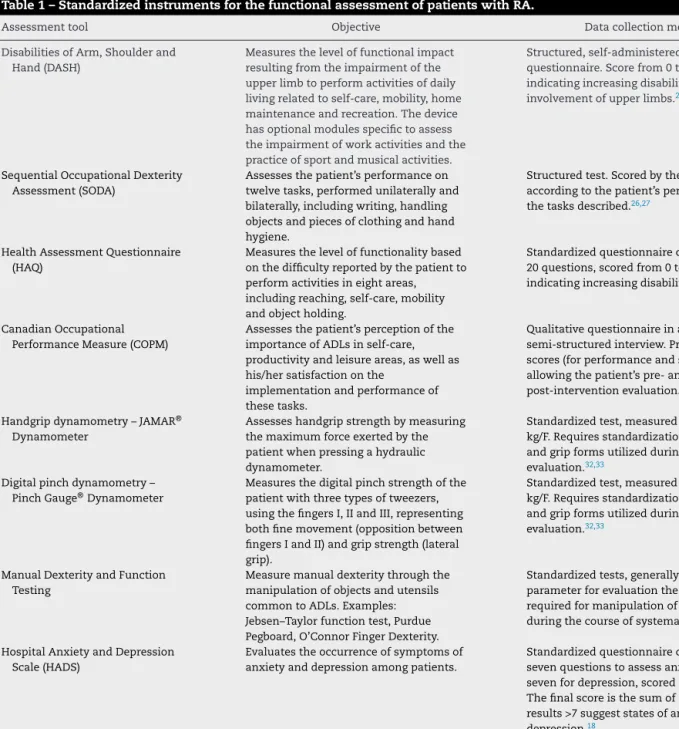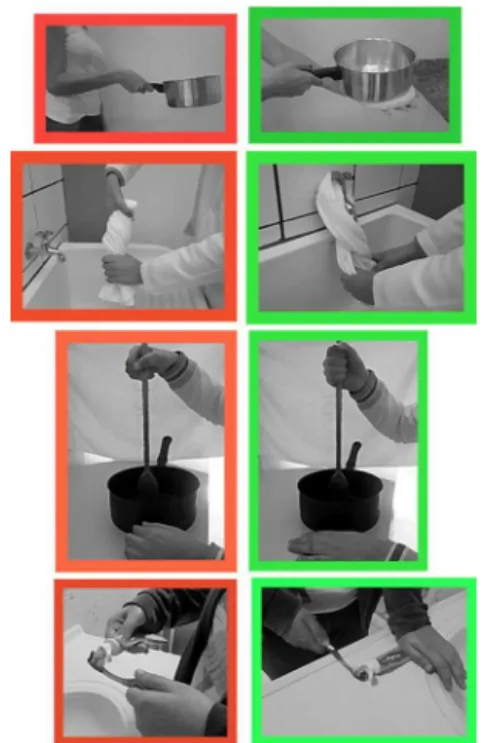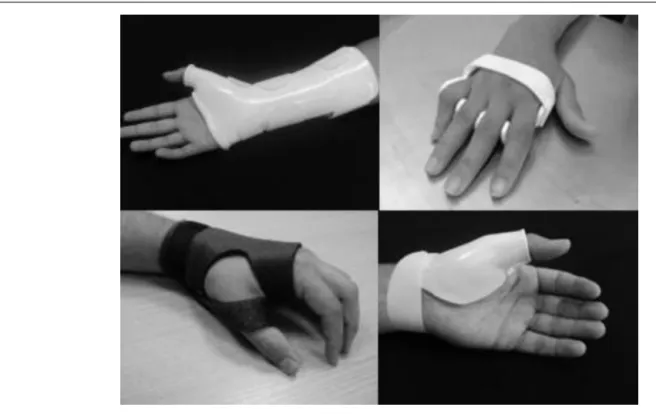w w w . r e u m a t o l o g i a . c o m . b r
REVISTA
BRASILEIRA
DE
REUMATOLOGIA
Review
article
Occupational
therapy
in
rheumatoid
arthritis:
what
rheumatologists
need
to
know?
夽
Pedro
Henrique
Tavares
Queiroz
de
Almeida
a,∗,
Tatiana
Barcelos
Pontes
a,
João
Paulo
Chieregato
Matheus
a,
Luciana
Feitosa
Muniz
b,
Licia
Maria
Henrique
da
Mota
baUniversidadedeBrasília,Brasilia,DF,Brazil
bHospitalUniversitáriodeBrasília,UniversidadedeBrasília,Brasília,DF,Brazil
a
r
t
i
c
l
e
i
n
f
o
Articlehistory:
Received11April2014 Accepted10July2014
Availableonline28November2014
Keywords:
Rheumatoidarthritis Rehabilitation
Activitiesofdailyliving Occupationaltherapy
a
b
s
t
r
a
c
t
Interventionsfocusingoneducationandself-managementofrheumatoidarthritis(RA)by thepatientimprovesadherenceandeffectivenessofearlytreatment.Thecombinationof pharmacologicandrehabilitationtreatmentaimstomaximizethepossibilitiesof inter-vention,delayingtheappearanceofnewsymptoms,reducingdisabilityandminimizing sequelae,decreasingtheimpactofsymptomsonpatient’sfunctionality.Occupational ther-apyisahealthprofessionthataimstoimprovetheperformanceofdailyactivitiesbythe patient,providingmeansforthepreventionoffunctionallimitations,adaptationtolifestyle changesandmaintenanceorimprovementofpsychosocialhealth.Duetothesystemic natureofRA,multidisciplinaryfollow-upisnecessaryforthepropermanagementofthe impactofthediseaseonvariousaspectsoflife.Asamemberofthehealthteam, occupa-tionaltherapistsobjectivetoimproveandmaintainingfunctionalcapacityofthepatient, preventingtheprogressionofdeformities,assistingtheprocessofunderstandingand cop-ingwiththediseaseandprovidingmeansforcarryingouttheactivitiesrequiredforthe engagementoftheindividualinmeaningfuloccupations,favoringautonomyand indepen-denceinself-careactivities,employment,educational,socialandleisure.Theobjectiveof thisreviewistofamiliarizetherheumatologistwiththetoolsusedforassessmentand interventioninoccupationaltherapy,focusingontheapplicationoftheseprinciplestothe treatmentofpatientswithRA.
©2014ElsevierEditoraLtda.Allrightsreserved.
夽
Institution:FaculdadedeCeilândia–CourseofOccupationalTherapy;HospitalUniversitáriodeBrasília–Rheumatology–Outpatient ClinicofEarlyRheumatoidArthritis.
∗ Correspondingauthor.
E-mail:pedroalmeida.to@gmail.com(P.H.T.Q.deAlmeida).
http://dx.doi.org/10.1016/j.rbre.2014.07.008
Terapia
ocupacional
na
artrite
reumatoide:
o
que
o
reumatologista
precisa
saber?
Palavras-chave:
Artritereumatoide Reabilitac¸ão
Atividadescotidianas Terapiaocupacional
r
e
s
u
m
o
Intervenc¸õesvoltadasparaaeducac¸ãoeoautogerenciamentodaartritereumatoide(AR) pelopacienteaumentamaadesãoeaeficáciadaabordagemprecoce.Acombinac¸ãode trata-mentomedicamentosoetratamentodereabilitac¸ãovisaapotencializaraspossibilidadesde intervenc¸ão,retardaroaparecimentodenovossintomas,reduzirincapacidades,minimizar sequelasereduziroimpactodossintomassobreafuncionalidadedopaciente.Aterapia ocupacionaléumaprofissãoda áreadasaúdequeobjetivaamelhoriadodesempenho deatividadespelo pacienteefornecemeiosparaaprevenc¸ãodelimitac¸õesfuncionais, adaptac¸ãoamodificac¸õesnocotidianoemanutenc¸ãooumelhoriadeseuestadoemocional eparticipac¸ãosocial.DevidoaocarátersistêmicodaARoacompanhamentomultidisciplinar énecessárioparaoadequadomanejodoimpactodadoenc¸asobreosmaisdiversosaspetos davidadopaciente.Comomembrodaequipedesaúde,oterapeutaocupacionalobjetiva amelhoriaemanutenc¸ãodacapacidadefuncionaldopaciente,preveniroagravamentode deformidades,auxiliaroprocessodecompreensãoeenfrentamentodadoenc¸a,fornecer meiosparaasatividadesnecessáriasparaoengajamentodoindivíduoemocupac¸ões signi-ficativas,favorecersuaautonomiaeindependênciaematividadesdeautocuidado,laborais, educacionais,sociaisedelazer.Oobjetivodestarevisãoéfamiliarizaroreumatologistacom asferramentasdeavaliac¸ãoeintervenc¸ãousadasnaterapiaocupacional,comenfoquena aplicac¸ãodessesprincípiosparaotratamentodepacientescomdiagnósticodeAR.
©2014ElsevierEditoraLtda.Todososdireitosreservados.
Introduction
Rheumatoidarthritis(RA)isasystemicautoimmunedisease characterizedbyimpairmentoftheperipheraljoints, espe-ciallyhandsandfeet.1Aprevalenceofuptothreetimeshigher
amongwomen isobserved,withincreasingincidenceafter
theageof25years,withgreaterinvolvementofpopulations between35and55years.2
AlthoughthereisnoconsensusontheetiologyofRA,itis observedthatthecombinationofinflammationandsynovial hypertrophy favor cartilage and bone destruction, promot-ingjointdamageandinstability,3predominantlyaffectingthe
joints ofthe wristand metacarpophalangealand proximal
interphalangealjointsofupperlimbs.4Forthesereasons,the treatmentofpatientsdiagnosedwithRAshouldbestartedas soonaspossible,aimingtoreducetheinflammatoryactivity ofthediseaseandeventoobtainremissionofsymptoms.5
Despite advances in the pharmacological treatment
achieved in the last 30 years, especially with the advent ofdisease-modifying anti-rheumatic drugs (DMARDs),6 the
chronicity of RA implies interventions aimed to the
edu-cation and self-management of the disease to favor the
treatment,increasingtheadherenceandeffectivenessofan earlyapproach.7,8
The combination of drug treatment and rehabilitation
therapyaimstomaximizethepossibilitiesofintervention,9 delaytheonsetofnewsymptoms,reducedisability,minimize sequelaeanddiminishtheimpactofsymptomson function-alityofthepatient.10,11
Occupationaltherapy(OT)isahealthcareprofessionwhich aimsatimprovingtheperformanceofactivitiesbythepatient, providingameansforthepreventionoffunctionallimitations,
adaptationtolifestylechangesandmaintenanceor improve-mentofhis/heremotionalstateandsocialparticipation.12
Theaimofthisreviewistofamiliarizetherheumatologist withtheassessmentandinterventiontoolsusedin occupa-tionaltherapy,focusingontheapplicationoftheseprinciples tothetreatmentofpatientsdiagnosedwithRA.
Multidisciplinary
treatment
–
practice
of
occupational
therapy
DuetothecharacteristicjointimpairmentofRA,the function-alityofthepatientisreducednotonlybythepainfulcondition, but alsobythosemotorconstraintsassociated.13 The diffi-cultyinperformingdailytasksisoneofthemaincomplaints ofpatientswiththedisease14,15causingrestrictionsinmostof theirareasofperformance16:fromsimpleactivitiesrelatedto self-careandhomemaintenancetocomplexworktasks,the patientpresentslimitationsindoingmanyofhis/heractivities ofdailyliving(ADLs).17
Itisobservedthatsuchrestrictionsaffectnotonlythe per-formanceoftheactivitiesindependentlyandautonomously, buthasanegativeimpactontheemotionalstate,social rela-tionshipsandqualityoflifeofthepatient.7,18
Given the participation constraints and the importance ofengaginginproductiveactivitiesforthe maintenanceof physicalandpsychosocialhealthofthispopulation,the occu-pationaltherapistisanintegralpartofthemultidisciplinary teamofcareforpatientswithRA,beingconcernedwiththe performanceofADLsandtheinclusionofthepatientin mean-ingfuloccupationsforhis/hereverydaylife.19,20
Table1–StandardizedinstrumentsforthefunctionalassessmentofpatientswithRA.
Assessmenttool Objective Datacollectionmethod
DisabilitiesofArm,Shoulderand Hand(DASH)
Measurestheleveloffunctionalimpact resultingfromtheimpairmentofthe upperlimbtoperformactivitiesofdaily livingrelatedtoself-care,mobility,home maintenanceandrecreation.Thedevice hasoptionalmodulesspecifictoassess theimpairmentofworkactivitiesandthe practiceofsportandmusicalactivities.
Structured,self-administered
questionnaire.Scorefrom0to100points, indicatingincreasingdisabilitydueto involvementofupperlimbs.24,25
SequentialOccupationalDexterity Assessment(SODA)
Assessesthepatient’sperformanceon twelvetasks,performedunilaterallyand bilaterally,includingwriting,handling objectsandpiecesofclothingandhand hygiene.
Structuredtest.Scoredbythetherapist, accordingtothepatient’sperformanceon thetasksdescribed.26,27
HealthAssessmentQuestionnaire (HAQ)
Measurestheleveloffunctionalitybased onthedifficultyreportedbythepatientto performactivitiesineightareas, includingreaching,self-care,mobility andobjectholding.
Standardizedquestionnaireconsistingof 20questions,scoredfrom0to3, indicatingincreasingdisability.28,29
CanadianOccupational PerformanceMeasure(COPM)
Assessesthepatient’sperceptionofthe importanceofADLsinself-care, productivityandleisureareas,aswellas his/hersatisfactiononthe
implementationandperformanceof thesetasks.
Qualitativequestionnaireinaformatof semi-structuredinterview.Providestwo scores(forperformanceandsatisfaction), allowingthepatient’spre-and
post-interventionevaluation.30,31
Handgripdynamometry–JAMAR® Dynamometer
Assesseshandgripstrengthbymeasuring themaximumforceexertedbythe patientwhenpressingahydraulic dynamometer.
Standardizedtest,measuredinpoundsor kg/F.Requiresstandardizationofpostures andgripformsutilizedduringthe evaluation.32,33
Digitalpinchdynamometry– PinchGauge®Dynamometer
Measuresthedigitalpinchstrengthofthe patientwiththreetypesoftweezers, usingthefingersI,IIandIII,representing bothfinemovement(oppositionbetween fingersIandII)andgripstrength(lateral grip).
Standardizedtest,measuredinpoundsor kg/F.Requiresstandardizationofpostures andgripformsutilizedduringthe evaluation.32,33
ManualDexterityandFunction Testing
Measuremanualdexteritythroughthe manipulationofobjectsandutensils commontoADLs.Examples: Jebsen–Taylorfunctiontest,Purdue Pegboard,O’ConnorFingerDexterity.
Standardizedtests,generallyusingasa parameterforevaluationthetime requiredformanipulationofobjects duringthecourseofsystematictasks.27
HospitalAnxietyandDepression Scale(HADS)
Evaluatestheoccurrenceofsymptomsof anxietyanddepressionamongpatients.
Standardizedquestionnairecontaining sevenquestionstoassessanxietyand sevenfordepression,scoredfrom0to3. Thefinalscoreisthesumofthepoints; results>7suggeststatesofanxietyand/or depression.18
foreachpatient, the firststeptowardthe realizationofan effectivetherapeuticinterventionistoobtainrelevantdataon thestateofthediseaseanditsimpactonthepatient’sADLs. Theevaluationisanongoingprocess,whichenablesthe mon-itoringoftreatmentandtheinterventionsneeded,aswellas themodificationoftheseduringperiodsofexacerbationand remission.21
Assessmentinoccupationaltherapy
Theevaluationaimsatobtainingdatarelatingtothephysical, emotionalandsocialstateofthepatient,aswellastheimpact ofthediseaseonhis/herADLs,providingobjectivedataonthe patient’soccupationalperformancethatallowmonitoringof his/herevolutionduringtreatment.22
Historically, occupational therapists combinethe use of semi-structuredinterviewsandstandardizedtoolsfor gather-inginformationtoenabletheestablishmentofabaselinefor thetherapy:diseasestatusandfunctionallimitations, expan-sionoftheunderstandingofthecontextsofapatient’slife, identificationofhis/herpriorities,monitoringofthedisease andtheeffectivenessofproposedinterventions.21The selec-tion ofassessmentmethodsshouldtakeinto consideration themaincomplaintsofthepatientandtheirrelevancetothe clinicalpresentation.23 Table1illustratessomeofthe stan-dardized assessmenttools thatcomprise the evaluationof patientswithRAbytheoccupationaltherapist.
(fatigue,pain,functionalcapacity),but alsotheinfluenceof this on the patient’s ability to engage and perform tasks relevanttohis/herday-to-day.12,21
Interventions
of
occupational
therapy
Patientguidanceandeducation–changinghabitstocope withillness
Thetransmissionofknowledgeandtheunderstandingofthe patientabouthis/herconditiondonotguarantee,byitself,any changeofattitudesnecessaryforthemanagementof compli-cationsarisingfromachronicdisease;sothatOThasasmain objectivethevoluntarychangeofhabits,extendedtoallareas ofthepatient’sperformanceandnotonlytothoseactivities afflictedbypainorbiomechanicalimbalancesdrivenbythe disease.24
ThemultidisciplinaryinterventionsforpatientswithRA
aim to control pain and fatigue, aiming their functional
improvementbycombiningdifferentmodalitiesoftreatment.
Among some of the interventions focused on patient
adjustmentandempowerment concerningthedisease,the
techniquesofjoint protectionandenergyconservation are examplesofchangesinhabits,bythewayofconductingADLs, whichpromotechangesnotonlyonfunctionalcapacity,but alsoon the psychological well-being, personalcontrol and
self-acceptance – fundamental concepts for improving the
qualityoflifeofthepatient.34
Jointprotectionandenergyconservation
Jointprotectiontechniquesareasetofguidelinesand preven-tivestrategiesusedinthemanagementofpainandfatigue,35 associatedwithothersymptomsinpatientswithRA,which aimtoapplyergonomicandbiomechanicalprincipleswhile performing ADLstoprotectjoint structures ofnormaland abnormalforces that may contribute to the installation of deformitiesoraggravatedeformitiesalreadypresent.36,37
Thisapproachwasfirstdescribedin1965,38throughthe
analysis of motor impairments motivated by the
inflam-matory process common to RA and its combination with
biomechanicalprinciples,aimingtominimizetheactionof forcesthatfavoredthedevelopmentofjointdeviationsand deformities during performing daily tasks,39 for example, hyperextensionofthemetacarpophalangealjointofthefinger I,ulnar deviationofmetacarpophalangeal jointsofthe fin-gersII–Vandinstallationofdeformitystandards,suchasswan neck,hammertoeorbuttonholetoe,throughinvolvementof distalinterphalangealjoints.40
Dueto theimportanceand constancynecessaryforthe
accomplishmentofADLs,modificationsintheirperformance allowasignificantreductioninjointstressandenergy expen-diture,facilitatingorenablingtheparticipationofthepatient inmeaningfuloccupations.36,37 Table2illustratesthe main guidelinesoftheconceptsofjointprotectionandenergy con-servation.
By modifying work methods and environments, use of
assistive devices (assistive technologies) and inclusion of breaksintheroutine,theobjectivehereisthereductionof
Table2–Principlesofjointprotectionandenergy conservation.
Jointprotection
Respectthepain–Useitasasigntochangetheactivity Distributetheloadonmorethanonejoint
Reducethestrengthandtheeffortrequiredtoperformsome activity,changingthewaytoperformit,usingassistivedevices orreducingtheweightofutensils
Useeachjointinitsmoststableandfunctionalanatomicalplane Avoidpositionsorforcesindirectionsthatfavordeformities Alwaysusethestrongerandlargerjointtowork
Avoidstayinginthesamepositionforaprolongedtime Avoidholdingobjectswithexcessiveforce
Avoidawkwardposturesandinappropriatewaystopickupand handleobjects
Maintainmusclestrengthandrangeofmotion
Energyconservation
Adjustyourdaybalancingmomentsofactivityandrest, alternatinglightandheavytasksandperformingactivitiesata slowerpace
Plantheconductionofyouractivities:prioritizeimportanttasks, useequipmenttoreducetheeffortanddelegatetaskswhen necessary
Whentired,avoidstartingtasksthatcannotbeinterrupted immediately
Modifytheenvironmentaccordingtopracticesofjoint protectionandergonomics
painatrestandduringmovement,byminimizing nocicep-tive stimuli onthe inflamed joint capsules, decreasing the forceincidentonthejointsandcontrollingenergy expendi-ture duringdailyactivities,enabling jointpreservation and improvementormaintenanceofthepatient’sfunctionality.41 Moreover,conductingactivitiestostrengthenthe periartic-ularmusclesandmaintainjointrangeofmotion,especially in the upper limbs, are also resources that contribute to themaintenanceorimprovementofthepatient’sfunctional capacity,42,43allowingabetterperformanceandpreservation ofjointstructuresimpairedbyRA.
Practicalexamplesofsomeofthetechniquesofjoint pro-tectionandenergyconservation44areillustratedinFig.1.
Randomized trials with high levels of evidence on the
effectivenessofmethodsofjointprotectionandenergy
con-servation showed significant improvement withrespect to
pain reductionamongpatientsreceiving theguidelines for
changes in their ADLs.45–47 Improvement in fatigue and
increasedsocialparticipation,47 reductionofmorning
stiff-ness, lower incidence of deformities in the hands48 and
improvedfunctionality49wereobserved,evenamongpatients withsevereRAstate.50
Modifyingactivitiesandworkenvironments
Althoughmostfunctionalassessmentshavefocusedonthe
difficultypresentedbythepatientwhileperformingself-care andmobilityactivities,dysfunctionsrelatedtoworkactivities representaseriousconsequenceofRA.51
Fig.1–Examplesofmodificationsinperformingactivities ofdailyliving.Theitemsontheleftindicatemovement patternsinwhichthepositionofthejointsofthewristand fingersenhancemechanicalforcestowarddeformities commonlyobservedamongpatientswithRA.The illustrationsontherightsuggestmodificationsthatfavor theuseofother,morestable,joints,orthedistributionof theloadamongmultiplejoints,avoidingpainfuland potentiallyharmfulpositions.
onethirdofpatientswillabandontheworkduringthefirst threeyearsofthedisease.52
Abandonmentofemploymentisalastresort,facetothe limitations encounteredbypatients withRA: before retire-ment,increasesofstresslevels,jobchanges,restrictionson workload, lossofpromotion opportunitiesand greater
fre-quency of absenteeism and of job changes are observed
moreoftenamongthispopulation.53Itisestimatedthatthe reductioninproductivity motivatedbyRAcausedlosses of approximately7000Euros/yearperpatient,54andupto25%of theworkingperiodmaybeaffectedbyconditionsrelatedto thedisease.55
Theearlytreatmentconductedbyamultidisciplinaryteam isaneffectivemethodtominimizecomplicationsrelatedto work, maintaining the work capacity of these patients for
a periodof time similar to that foundamong the healthy
population.51,55
Giventhemultiplicityofsituationsandperceptionsabout work activity reported by patients, individualized strate-giesareindicatedasthebestapproachtolabordifficulties, including a specific evaluation ofthe situation and ofthe workplace.52
Changes for a better performance of the activity may
includetheorganizationofthetasksthatcomposethework activity,changingshifts,andafairdivisionoftheworkload throughouttheday56;ergonomicmodificationssuchasnew furnitureand changesin theworkplace,ensuringa proper
joint positioningduring activity,replacementoffixturesby otherofsmallerweightorwithbetterhandgrip57andguidance onstressmanagementandacquisitionofstrategies(coping) tohandlewiththeworkload.58
Althoughsomereviewstudiesshownohighlevelevidence on the effectivenessofspecific ergonomic interventionsto reduceproblemsrelatedtoupperlimbs,59 thereis satisfac-toryevidencetosupportsuchinterventionswithrespectto patientswithRA,57suggestingimprovementinfunctionality, painandsatisfactionwiththeworkinthelongterm,when comparedtoindividualswhodidnotgettheseinterventions.
Assistivetechnologies–orthoticsandadaptations
Theconceptofassistivetechnologyincludesdevices, guide-linesandpracticesthataimtomaintain,enhanceorfacilitate
the performance of self-care, instrumental, educational,
employmentorsocialactivities.60
Amongtherangeofinstrumentsavailabletopatientswith RA,theadaptationsofutensilsandtheuseoforthoticsare someofthemajorresourcestopromoteimprovedgrip, biome-chanical alignmentandjointstressreduction,aswell asto allow the development ofactivities and occupations, con-tributingtothepatient’sfunctionalityandautonomy.61
Theadaptationofutensilsrequiresathoroughanalysisof theactivityperformedbythepatient,inordertodetermine whatarethemainchallengesencounteredandpossible solu-tions tobeproposed.Suchmodifications mayincludefrom changesinthewayofconductingtheactivity(suchas guid-anceonjointprotectionandenergyconservation)tochanges intheshape,weightandsizeofutensils.
Thickerhandlesandadaptationstofacilitateorreplacethe handgrip strength,for example,elasticor neoprene strips, favorthe handling ofcutlery, writinginstruments and
per-sonal hygiene materials, such as toothbrushes and hair
combs.
Thereplacementofdrinkingglassesformugs,theuseof modifiedcuttingboards,soapanddetergentdispensersand clotting adaptationsare examples ofsimpledevices which promote important functional changes to the patient.62–64 Examplesofadaptationstopromoteimprovementin perform-ingADLsareillustratedinFig.2.
Orthoses(splints)areresourcesusedbytherapiststo pro-motebetterjointsupport,reducepainandoptimizefunctional performanceof thepatient.65 Althoughseveral models are available,clinicalreasoningusedforprescribinganorthosis involves theneedsforeach case;thesame orthosiscanbe prescribedformultipleobjectives.
Among the most common indications, pain control,
decreasedmorning stiffness,mechanicalsupportforjoints, encouragement ofjoint motion and functionality, and cer-tainpostoperativesituations(wherethecombinationofjoint alignment,immobilizationandapplicationoftractionforces isrequired)canbecited.66–68Somemodelsoforthoses com-monlyindicatedareillustratedinFig.3.
Fig.2–Adaptedutensils.Theproposedadjustmentsarebasedontheprinciplesofjointprotectionandenergy conservation,withdistributionofmechanicalloadsandpromotingtheuseoflargerjointsduringactivities.
Fig.3–Examplesoforthosesforupperlimbs,suggestedforpatientswithRA.
promoteimprovementinpainandmorningstiffnessforthe patient.68,69
Bracesusedforstabilizationoftheinterphalangealjoints alsoexhibitsignificant levels ofevidenceinreducing pain, althoughnosignificantchangesonhandfunctionorstrength duringitsusehavebeenobserved.70
Conclusions
DuetothesystemicnatureofRA,amultidisciplinary
follow-up isnecessary forthe propermanagement ofthe impact
ofthe disease onvarious aspectsof lifeofthe patient. As
a member of the health team, the occupational therapist
aimsto improve and maintain his/her patient’s functional
capacity,preventingtheworseningofdeformities,aidingin the process ofunderstandingand coping withthedisease, andprovidingmeansforcarryingouttheactivitiesrequired fortheengagementoftheindividualinmeaningful occupa-tions,contributingtohis/herautonomyandindependencein self-care,labor,educational,socialandleisureactivities.
Itisimportantthattherheumatologistbecomeawareof thegeneralprinciplesoftherapy,sothathe/shecansuggest theirusemoreconsciously,asanadditionaltoolinthe treat-mentofpatientsdiagnosedwithRA.
Conflict
of
interest
r
e
f
e
r
e
n
c
e
s
1. MotaLMH,CruzBA,BrenolCV,PereiraIA,Rezende-FronzaLS, BertoloMB,etal.Consenso2012daSociedadeBrasileirade Reumatologiaparaotratamentodaartritereumatoide. RevistaBrasileiradeReumatologia.2012;52:152–74.
2. LipskyPE.Rheumatoidarthritis.In:FauciAS,LangfordCA, editors.Harrison’srheumatology.2nded.McGraw-Hill Professional;2010.p.82–99.
3. PitzalisC,KellyS,HumbyF.Newlearningsonthe pathophysiologyofRAfromsynovialbiopsies.CurrOpin Rheumatol.2013;25:334–44.PubMedPMID:23492740.Epub 2013/03/16.eng.
4. BeasleyJ.Osteoarthritisandrheumatoidarthritis: conservativetherapeuticmanagement.JHandTher. 2012;25:163–71,quiz72.PubMedPMID:22326361.Epub 2012/02/14.eng.
5. MotaLMHd,LaurindoIMM,SantosNetoLLd.Artrite reumatoideinicial:conceitos.RevistadaAssociac¸ãoMédica Brasileira.2010;56:227–9.
6. FiresteinGS.Etiologyandpathogenesisofrheumatoid arthritis.In:FiresteinGS,BuddRC,GabrielSE,McInnesIB, O’DellJR,editors.Kelley’sTextbookofRheumatologyII.9th ed.Philadelphia:ElsevierSaunders;2013.p.1059–108.
7. OttenvallHammarI,HakanssonC.Theimportancefordaily occupationsofperceivinggoodhealth:perceptionsamong womenwithrheumaticdiseases.ScandJOccupTher. 2013;20:82–92.PubMedPMID:22784433.Epub2012/07/13.eng.
8. PrimdahlJ,WagnerL,HolstR,Horslev-PetersenK.Theimpact onself-efficacyofdifferenttypesoffollow-upcareand diseasestatusinpatientswithrheumatoidarthritis–a randomizedtrial.PatientEducCouns.2012;88:121–8.PubMed PMID:22386009.Epub2012/03/06.eng.
9. MarionCE,BalfeLM.Potentialadvantagesof
interprofessionalcareinrheumatoidarthritis.JManageCare Pharm.2011;17Suppl.B:S25–9.PubMedPMID:22073937.Epub 2011/12/07.eng.
10.HammondA,NiedermannK.Patienteducationandself
management.In:DziedzicK,HammondA,editors.
Rheumatology–evidence-basedpracticeforphysiotherapists andoccupationaltherapists.UnitedKingdom:Elsevier;2010. p.78–93.
11.HandC,LawM,McCollMA.Occupationaltherapy interventionsforchronicdiseases:ascopingreview.AmJ OccupTher.2011;65:428–36.PubMedPMID:21834458.Epub 2011/08/13.eng.
12.HammondA.Whatistheroleoftheoccupationaltherapist? BestPractResClinRheumatol.2004;18:491–505.
13.LutzeU,ArchenholtzB.Theimpactofarthritisondailylife withthepatientperspectiveinfocus.ScandJCaringSci. 2007;21:64–70.PubMedPMID:17428216.Epub2007/04/13.eng.
14.NymanA,LundML.Influencesofthesocialenvironmenton engagementinoccupations:theexperienceofpersonswith rheumatoidarthritis.ScandJOccupTher.2007;14:63–72. PubMedPMID:17366079.Epub2007/03/17.eng.
15.ReinsethL,EspnesGA.Womenwithrheumatoidarthritis: non-vocationalactivitiesandqualityoflife.ScandJOccup Ther.2007;14:108–15.
16.MathieuxR,MarotteH,BattistiniL,SarrazinA,BerthierM, MiossecP.Earlyoccupationaltherapyprogrammeincreases handgripstrengthat3months:resultsfromarandomised, blind,controlledstudyinearlyrheumatoidarthritis.Ann RheumDis.2009;68:400–3.PubMedPMID:19015209.Epub 2008/11/19.eng.
17.Malcus-JohnsonP,CarlqvistC,SturessonAL,EberhardtK. Occupationaltherapyduringthefirst10yearsofrheumatoid
arthritis.ScandJOccupTher.2005;12:128–35.PubMedPMID: 16389738.Epub2006/01/05.eng.
18.MellaLFB,BértoloMB,DalgalarrondoP.Depressivesymptoms inrheumatoidarthritis.RevistaBrasileiradePsiquiatria. 2010;32:257–63.
19.EngelJM.Physiotherapyandergotherapyareindispensable. Concreteprescriptionofremedies-withoutrecourse. ZRheumatol.2012;71:369–80.
20.AdamsJ,BurridgeJ,MulleeM,HammondA,CooperC. Correlationbetweenupperlimbfunctionalabilityand structuralhandimpairmentinanearlyrheumatoid population.ClinRehabil.2004;18:405–13.
21.SandsA,GoodacreL.Occupationaltherapyassessmentand outcomemeasurement.In:GoodacreL,McArthurM,editors. Rheumatologypracticeinoccupationaltherapy.1sted. Oxford:Wiley-Blackwell;2013.
22.McDonaldHN,DietrichT,TownsendA,LiLC,CoxS,Backman CL.Exploringoccupationaldisruptionamongwomenafter onsetofrheumatoidarthritis.ArthritisCareRes(Hoboken). 2012;64:197–205.PubMedPMID:22006430.Epub2011/10/19. eng.
23.FeldmanDE,BernatskyS,LevesqueJF,VanMT,HoudeM,April KT.Accessandperceivedneedforphysicalandoccupational therapyinchronicarthritis.DisabilRehabil.2010;32:1827–32. PubMedPMID:20345251.Epub2010/03/30.eng.
24.AktekinLA,EserF,BaskanBM,SivasF,MalhanS,OksuzE, etal.Disabilityofarmshoulderandhandquestionnairein rheumatoidarthritispatients:relationshipwithdisease activity,HAQ,SF-36.RheumatolInt.2011;31:823–6.PubMed PMID:20680284.Epub2010/08/04.eng.
25.OrfaleAG,AraújoPMP,FerrazMB,NatourJ.Translationinto BrazilianPortuguese,culturaladaptation,andevaluationof thereliabilityofthedisabilitiesofthearm,shoulderand handquestionnaire.BrazJMedBiolRes.2005;38:293–302.
26.VanLankveldW,van’tPadBoschP,BakkerJ,TerwindtS, FranssenM,vanRielP.Sequentialoccupationaldexterity assessment(Soda):anewtesttomeasurehanddisability.J HandTher.1996;9:27–32.PubMedPMID:8664936.Epub 1996/01/01.eng.
27.OkuEC,PinheiroGRC,AraújoPMP.Instrumentosdeavaliac¸ão funcionaldamãoempacientescomartritereumatoide. FisioterapiaemMovimento.2009;22:221–8.
28.FerrazMB,OliveiraLM,AraujoPM,AtraE,TugwellP. Crossculturalreliabilityofthephysicalabilitydimensionof thehealthassessmentquestionnaire.JRheumatol. 1990;17:813–7.PubMedPMID:2388204.Epub1990/06/01.eng.
29.CorbachoMI,DapuetoJJ.Avaliac¸ãodacapacidadefuncionale daqualidadedevidadepacientescomartritereumatoide. RevistaBrasileiradeReumatologia.2010;50:31–43.
30.LawM,BaptisteS,McCollM,OpzoomerA,PolatajkoH,Pollock
N.TheCanadianoccupationalperformancemeasure:an
outcomemeasureforoccupationaltherapy.CanJOccupTher. 1990;57:82–7.PubMedPMID:10104738.Epub1990/04/01.eng.
31.MeestersJ,PontW,Beaart-VanDeVoordeL,StammT,Vliet VlielandT.Dorehabilitationtoolscovertheperspectiveof patientswithrheumatoidarthritis?Afocusgroupstudy usingtheICFasareference.EurJPhysRehabilMed.2013;23. PubMedPMID:23698472.Epub2013/05/24.Eng.
32.FraserA,VallowJ,PrestonA,CooperRG.Predicting“normal” gripstrengthforrheumatoidarthritispatients.Rheumatology (Oxford).1999;38:521–8.PubMedPMID:10402072.Epub 1999/07/13.eng.
33.KennedyD,Jerosch-HeroldC,HicksonM.Thereliabilityof onevs.threetrialsofpain-freegripstrengthinsubjectswith rheumatoidarthritis.JHandTher.2010;23:384–90,quiz91. PubMedPMID:20971419.Epub2010/10/26.eng.
2009;23:103–16.PubMedPMID:19233050.Epub2009/02/24. eng.
35.NiedermannK,HammondA,ForsterA,deBieR.Perceived benefitsandbarrierstojointprotectionamongpeoplewith rheumatoidarthritisandoccupationaltherapists.Amixed methodsstudy.MusculoskeletCare.2010;8:143–56.PubMed PMID:20803632.Epub2010/08/31.eng.
36.HammondA.Jointprotection.In:GoodacreL,McArthurM, editors.Rheumatologypracticeinoccupationaltherapy.1st ed.Oxford:Willey-Blackwell;2013.p.111–32.
37.NoordhoekJ,LoschiavoFQ.Intervenc¸ãodaterapia ocupacionalnotratamentodeindivíduoscomdoenc¸as reumáticasutilizandoaabordagemdaprotec¸ãoarticular. RevistaBrasileiradeReumatologia.2005;45:242–4.
38.CorderyJC.Jointprotection;aresponsibilityofthe occupationaltherapist.AmJOccupTher.1965;19:285–94. PubMedPMID:5832168.Epub1965/09/01.eng.
39.CorderyJC.Jointdeformityinrheumatoidarthritis.AmJ OccupTher.1965;19:243–8.PubMedPMID:5832161.Epub 1965/09/01.eng.
40.KozlowJH,ChungKC.Currentconceptsinthesurgical
managementofrheumatoidandosteoarthritichandsand
wrists.HandClin.2011;27:31–41.PubMedPMID:21176798.
PubmedCentralPMCID:PMC3053090.Epub2010/12/24.eng.
41.NiedermannK,BuchiS,CiureaA,KubliR,Steurer-SteyC, VilligerPM,etal.Sixand12months’effectsofindividual jointprotectioneducationinpeoplewithrheumatoid arthritis:arandomizedcontrolledtrial.ScandJOccupTher. 2012;19:360–9.PubMedPMID:21936735.Epub2011/09/23.eng.
42.HochbergMC,AltmanRD,AprilKT,BenkhaltiM,GuyattG, McGowanJ,etal.AmericanCollegeofRheumatology2012
recommendationsfortheuseofnonpharmacologicand
pharmacologictherapiesinosteoarthritisofthehand,hip, andknee.ArthritisCareRes(Hoboken).2012;64:465–74. PubMedPMID:22563589.Epub2012/05/09.eng.
43.LarkinL,KennedyN.Correlatesofphysicalactivityinadults withrheumatoidarthritis:asystematicreview.JPhysAct Health.2013;19.PubMedPMID:23963816.Epub2013/08/22. Eng.
44.AlmeidaPHTQ,SimeMM,MendesJB,BittencourtG,Ferrigno ISV.Comoprotegersuasarticulac¸ões–Manualdeprotec¸ão articulareconservac¸ãodeenergiaparapacientescom doenc¸asreumatológicas.SãoCarlos:UniversidadeFederalde SãoCarlos;2012.
45.ChristieA,JamtvedtG,DahmKT,MoeRH,HaavardsholmEA, HagenKB.Effectivenessofnonpharmacologicaland nonsurgicalinterventionsforpatientswithrheumatoid arthritis:anoverviewofsystematicreviews.PhysTher. 2007;87:1697–715.PubMedPMID:17906290.Epub2007/10/02. eng.
46.HammondA,BryanJ,HardyA.Effectsofamodular behaviouralarthritiseducationprogramme:apragmatic parallel-grouprandomizedcontrolledtrial.Rheumatology (Oxford).2008;47:1712–8.PubMedPMID:18815153.Epub 2008/09/26.eng.
47.HammondA,FreemanK.Thelong-termoutcomesfroma
randomizedcontrolledtrialofaneducational-behavioural jointprotectionprogrammeforpeoplewithrheumatoid arthritis.ClinRehabil.2004;18:520–8.PubMedPMID:15293486. Epub2004/08/06.eng.
48.SteultjensEM,DekkerJ,BouterLM,VanSchaardenburgD,
VvanKuykMA,VandenEndeCH.Occupationaltherapyfor
rheumatoidarthritis.CochraneDatabaseSystRev. 2004:CD003114.PubMedPMID:14974005.Epub2004/02/20. eng.
49.MasieroS,BonioloA,WassermannL,MachiedoH,VolanteD, PunziL.Effectsofaneducational-behavioraljointprotection programonpeoplewithmoderatetosevererheumatoid
arthritis:arandomizedcontrolledtrial.ClinRheumatol. 2007;26:2043–50.PubMedPMID:17404783.Epub2007/04/04. eng.
50.NilssonI,FitinghoffH,LiljaM.Continuingtoworkafterthe onsetofrheumatoidarthritis.Work.2007;28:335–42.PubMed PMID:17522454.Epub2007/05/25.eng.
51.Tiippana-KinnunenT,PaimelaL,PeltomaaR,KautiainenH, LaasonenL,Leirisalo-RepoM.WorkdisabilityinFinnish patientswithrheumatoidarthritis:a15-yearfollow-up.Clin
ExpRheumatol.2013.PubMedPMID:24143915.Epub
2013/10/23.Eng.
52.MacedoAM,OakleySP,PanayiGS,KirkhamBW.Functional
andworkoutcomesimproveinpatientswithrheumatoid
arthritiswhoreceivetargeted,comprehensiveoccupational therapy.ArthritisRheum.2009;61:1522–30.PubMedPMID: 19877106.Epub2009/10/31.eng.
53.BansbackN,ZhangW,WalshD,KielyP,WilliamsR,GuhD, etal.Factorsassociatedwithabsenteeism,presenteeismand activityimpairmentinpatientsinthefirstyearsofRA. Rheumatology(Oxford).2012;51:375–84.PubMedPMID: 22179728.Epub2011/12/20.eng.
54.PuolakkaK,KautiainenH,PekurinenM,MottonenT, HannonenP,KorpelaM,etal.Monetaryvalueoflost productivityoverafiveyearfollowupinearlyrheumatoid arthritisestimatedonthebasisofofficialregisterdataon patients’sicknessabsenceandgrossincome:experience fromtheFIN-RACotrial.AnnRheumDis.2006;65:899–904.
PubMedPMID:16291811.PubmedCentralPMCID:
PMC1798230.Epub2005/11/18.eng.
55.PuolakkaK,KautiainenH,MottonenT,HannonenP,Korpela M,HakalaM,etal.Earlysuppressionofdiseaseactivityis essentialformaintenanceofworkcapacityinpatientswith recent-onsetrheumatoidarthritis:five-yearexperiencefrom theFIN-RACotrial.ArthritisRheum.2005;52:36–41.PubMed PMID:15641055.Epub2005/01/11.eng.
56.Herrera-SarayP,Pelaez-BallestasI,Ramos-LiraL,
Sanchez-MonroyD,Burgos-VargasR.Usageproblemsand
socialbarriersfacedbypersonswithawheelchairandother aidsqualitativestudyfromtheergonomicsperspectivein personsdisabledbyrheumatoidarthritisandother conditions.ReumatolClín.2013;9:24–30.PubMedPMID: 22854174.Epub2012/08/03.eng.
57.BaldwinD,JohnstoneB,GeB,HewettJ,SmithM,SharpG. Randomizedprospectivestudyofaworkplaceergonomic interventionforindividualswithrheumatoidarthritisand osteoarthritis.ArthritisCareRes(Hoboken).2012;64:1527–35. PubMedPMID:22511570.Epub2012/04/19.eng.
58.Daker-WhiteG,DonovanJ,CampbellR.Redefinedbyillness: meta-ethnographyofqualitativestudiesontheexperienceof rheumatoidarthritis.DisabilRehabil.2013.PubMedPMID: 24001261.Epub2013/09/05.Eng.
59.HoeVC,UrquhartDM,KelsallHL,SimMR.Ergonomicdesign andtrainingforpreventingwork-relatedmusculoskeletal disordersoftheupperlimbandneckinadults.Cochrane DatabaseSystRev.2012;8:CD008570.PubMedPMID:22895977. Epub2012/08/17.eng.
60.TuntlandH,KjekenI,NordheimL,FalzonL,JamtvedtG, HagenK.TheCochranereviewofassistivetechnologyfor rheumatoidarthritis.EurJPhysRehabilMed.2010;46:261–8. PubMedPMID:20485228.Epub2010/05/21.eng.
61.WilsonDJ,MitchellJM,KempBJ,AdkinsRH,MannW.Effects ofassistivetechnologyonfunctionaldeclineinpeopleaging withadisability.AssistTechnol:OffJResna.2009;21:208–17. PubMedPMID:20066887.Epub2010/01/14.
eng.
63.NoordhoekJ,TorquettiA.Adaptac¸ãoparafacilitardescascar alimentos.RevistaBrasileiradeReumatologia.2007;47:52.
64.NoordhoekJ,TorquettiA.Adaptac¸õesparaosteoartritede mãos.RevistaBrasileiradeReumatologia.2008;48:100–1.
65.EganM,BrosseauL,FarmerM,OuimetMA,ReesS,WellsG, etal.Splints/orthosesinthetreatmentofrheumatoid arthritis.CochraneDatabaseSystRev.2003;1:CD004018. PubMedPMID:12535502.Epub2003/01/22.eng.
66.EganMY,BrousseauL.Splintingforosteoarthritisofthe carpometacarpaljoint:areviewoftheevidence.AmJOccup Ther.2007;61:70–8.PubMedPMID:17302107.Epub2007/02/17. eng.
67.FormsmaSA,VanderSluisCK,DijkstraPU.Effectivenessofa MP-blockingsplintandtherapyinrheumatoidarthritis:a descriptivepilotstudy.JHandTher.2008;21:347–53.PubMed PMID:19006761.Epub2008/11/14.eng.
68.VeehofMM,TaalE,Heijnsdijk-RouwenhorstLM,VandeLaar MA.Efficacyofwristworkingsplintsinpatientswith rheumatoidarthritis:arandomizedcontrolledstudy.Arthritis
Rheum.2008;59:1698–704.PubMedPMID:19035420.Epub
2008/11/28.eng.
69.SilvaAC,JonesA,SilvaPG,NatourJ.Effectivenessofa night-timehandpositioningsplintinrheumatoidarthritis:a randomizedcontrolledtrial.JRehabilMed.2008;40:749–54. PubMedPMID:18843428.Epub2008/10/10.eng.


